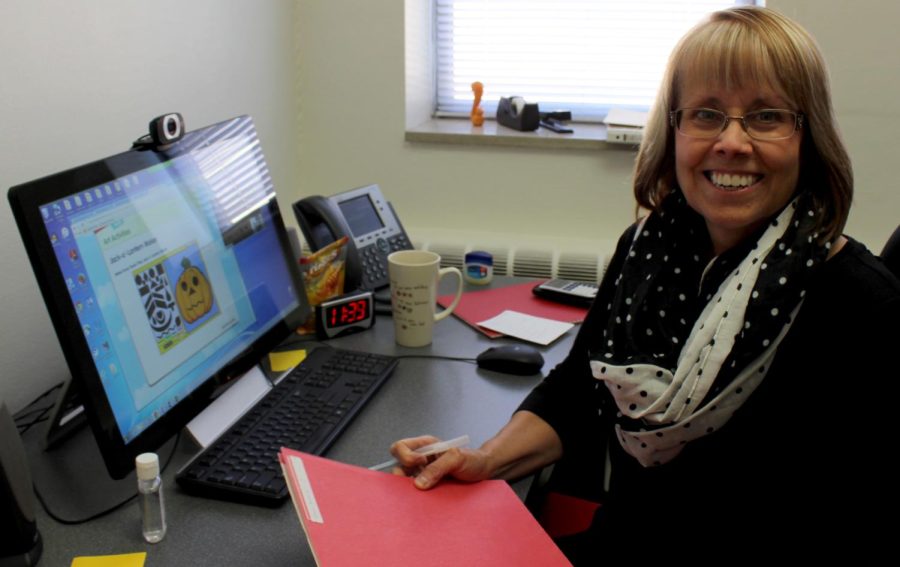Telepresence advances student therapy
Patty Chafin sits in her office in the Speech Pathology wing of the Center for Performing Arts on Oct. 20, 2015. Chafin works with children who have speech impediments and uses computer games as incentives.
October 21, 2015
Excitement, eagerness and confidence grace children’s faces as they adjust the camera during their speech pathology and audiology therapy session at Greenfield Exempted Village Schools.
Kent State offers telepresence therapy — which involves interaction between a specialist and a student — through the services of Cisco’s WebEx, a collaborative software that allows for videoconferencing, interactive online training, webinars and presentations to Greenfield’s K-12 classes.
The videoconferencing therapy sessions last for 20 minutes and allows therapists to interact with students similar to a face-to-face therapy session.
“One of the things I really like about this is that I see my students individually,” said Patricia Chafin, a project coordinator in the Health Sciences department. “It’s so child-based. I feel like the focus is truly on the kids.”
Chafin said her entire career was spent in a more traditional therapy session at schools. Using telepresence makes the children more attentive, she found.
“I think the children, at least in (this) day and age… would automatically focus on a computer,” she said. “They attend better through the telepractice models than they did when they were in the room with me.”
Chafin said the interactive video therapy and programs do a great deal in enlightening the children. The audio quality in WebEx allows for her to disseminate the speech sounds of the students well, similar to the traditional therapy session, but she said there are both pros and cons to such a service.
“One thing that I miss is when I’m teaching speech sound production. Sometimes I wish I could touch (the student’s face to help them form the sound),” she said, while pantomiming the motions of speech pathology therapy. “Otherwise, I think you can do virtually anything you would do in a traditional therapy setting.”
Susan Grogan-Johnson, an associate professor of speech pathology and audiology in the health sciences department, said her research suggested there was not a significant difference in the amount of improvement for a student utilizing telepractice services compared to face-to-face therapy.
“We’re not trying to show that telepractice is better,” she said. “We’re just trying to show that if (therapy) is done by telepractice, (progress) will look about the same.”
Lauren Ledzianowski, a graduate student majoring in speech language pathology, said — when conducting her therapy sessions — she saw a significant amount of improvement in her students.
“It was like being right next to each other,” Ledzianowski said. “I can see growth in the data I collected in the short amount of time.”
Ledzianowski said that although the therapy is over the course of a web conference, she can still see the children’s determination in achieving their goals.
“When they finally get to where they want to be, it’s exciting,” she said. “Even though we’re over a webcam conference, it’s still sharing in the excitement with each other. It doesn’t differ just because it’s over video conference (rather than) in person.”
Grogan-Johnson said one of the big differences when it comes to telepresence therapy is efficiency pertaining to time. She said the web conferences make consulting more accessible because there aren’t a lot of specialists in rural areas where a lot of the schools are located.
“One of the rural districts we work (in took) almost an hour for me to get (to),” she said. “With telepractice, I switch off from one school and a minute later I’m switched on to a new school.”
Sarah King, a graduate student majoring in speech language pathology, said she would prefer to do in-person sessions, but the skills she has learned while working with telepresence will prepare her for her career path.
“I think it’s a good bridge or stepping stone for me, especially this semester because I will be transitioning to my school-based placement,” she said. “I feel like it’s better to get that experience now with collecting the data live and having to move along through your tasks pretty efficiently and quickly.”
Grogan-Johnson said telepractice therapy has become more acceptable with speech pathology specialists and video therapy will be seen more frequently in the future.
Toni Hunt is the education, health and human services reporter. Contact her at [email protected].












